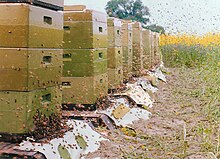Magazine loot


Magazine hives (also: Langstroth hives ) are artificial nesting holes for honey bees . They are used in modern beekeeping as a home ( prey ) for honey bees .
construction
Magazine hives consist of a bottom, one or more frames placed one above the other in the middle and a lid. In the wooden or plastic frame , which is open at the top and bottom, frames with the honeycomb are hung from above . The bottom has an entrance hole (slot) and the lid has a cover as weather protection. Depending on the population size, which fluctuates strongly in temperate latitudes over the course of the year, one to a maximum of four or even five boxes are used per colony and prey.
In contrast to the horizontal hive , the colony development takes place in the magazine hive from bottom to top ( vertical ). In the lower area of the magazine hive is the brood chamber with the brood nest, above the honey chamber with the honeycombs. For beekeeping as close to nature as possible, an uninterrupted brood nest is sought, which is only possible with a sufficiently large brood space. In order to create pure honeycombs, a so-called barrier is often used between the brood and honey room. This prevents the honey space from incubating, as the relatively large queen bee cannot fit through the grid and cannot lay eggs in the honey space.
The original form of the vertical magazine hive goes back to the American beekeeper Lorenzo L. Langstroth (1810–1895), who introduced a frame measure named after him and discovered the bee-space, the natural ideal distance between the honeycomb and the hive wall.
A variant of Langstroth prey is z. B. the Dadant prey . Here different frames - and thus frame sizes for the brood chamber and the honey chamber are used. So-called half or flat frames (only half high) are used for other types of magazine hives . The aim of all of these variants is to be able to harvest smaller amounts of honey (so-called Läppertrachten) and to enable the honey to mature better. Most often, however, bees are only kept with a single frame size, because this enables more uniform material storage: A single frame type can be used universally for the brood and honey space, the transport of honeycombs and the storage of surplus cells (frames) in the winter months. In addition, non-incubated honeycombs from the previous year can be used to expand the incubation space from one to two frames. This makes honeycomb renewal and hygiene easier in spring. Most methods of honeycomb renewal work with completely new center walls.
Magazine mode of operation
The most common breeds of western honeybees ( Apis mellifera ) are kept in beekeeping around the world and mainly magazine hives are used for this. No apiary is required to accommodate the magazine hives . The bee colonies are set up in these containers all year round, individually or next to each other (as a group) on a simple, floor-level wooden frame (walking trestle) outdoors. A major advantage of this modular and very flexible mode of operation is the low effort involved in adjusting the bee colonies, e.g. B. when migrating in individual flower or honeydew costumes.
Up until the mid-1960s, bees in Germany, Austria and Switzerland were mainly kept in fixed apiaries with so-called back- treatment hives. Beehive wagons were very common in the GDR until reunification . In the meantime, these classic modes of operation have largely been replaced by the simpler magazine mode of operation, or new beehouses and wagons are no longer built, or at least, if they still exist, they are also equipped with magazine hives.
In some areas ( Mediterranean , Africa ) are in the mobile beekeeping predominantly compact camp booties used (without frames-set-up), where the honey spaces not like the usual stand booties above, but in addition to the breeding areas. The processing takes place here from above, otherwise the mode of operation is essentially similar to that of magazine hives.
For the bees, it does not matter what type of housing people provide them, as long as the size of this "artificial cave" corresponds to the dynamics of the people. Further requirements are protection from direct weather influences such as moisture and drafts. The regionally adapted bees do not mind the dry cold in winter, as the bee scientist Gerhard Liebig has proven in studies at the State Institute for Beekeeping at the University of Stuttgart-Hohenheim .
See also
literature
- Karl Pfefferle: Beekeepers with the magazine and with varroosis: the manual for the magazine beekeeper ; 8., revised. Ed .; Münstertal: Self-published by Pfefferle 1990
- Karl Kieß: Building instructions for the Zander magazine - compatible system - , Lindenberg 1998
- Karl Weiß: The weekend beekeeper, A school for beekeeping with magazines , 10th edition Munich, 1996, ISBN 3-431-02275-8
- Werner Schundau: This is how we keep beekeeping in the Seegeberger Kunststoff-Magazinbeute , 4th edition Brockel, 2003

